Navel - empathic robot for care
Navel has been in use as a pre-series product in several care homes since October 2023. We want to address various aspects of the topic of robots in care here.
Topics
Good care
Robots in care
Social superpowers of social robots
Robots with empathy?
Do people in need of care want to interact with social robots?
Use cases of Navel in care (loneliness, activation, dementia, relief, etc.)
Privacy policy at Navel
Good care
People in need of care have a right to receive good care. What we understand and expect by “good care” varies from person to person and changes over time. In October 2019, the Federal Ministry of Health began the gradual introduction of a new quality system for inpatient care. In this system, the quality of results plays a much greater role than just the review of implemented measures.
In its opinion “Robotics for good care“, the German Ethics Council refers to the “Charter of the Rights of People in Need of Assistance and Care” and writes that good care primarily comprises two different tasks: In addition to maintaining, restoring or even promoting physical, mental, psychological or even sensory-related functions, “communication, relationship and emotional work” is also at the center of good care.
Whereas in the past the focus was primarily on the instrumental and task-related, i.e. body-related aspects of care, today increasing emphasis is also being placed on cognitive and emotional care activities. This is because it prevents illnesses such as dementia and depression, which are becoming increasingly common. Such care activities therefore directly increase well-being, which in turn indirectly improves physical health.
Physical care activities
Bathing, physical (walking) training, giving medication or food, accompanying to the toilet, physical assessment
Cognitive & emotion-related care activities
Interaction, cooperation work, cognitive training, emotional work
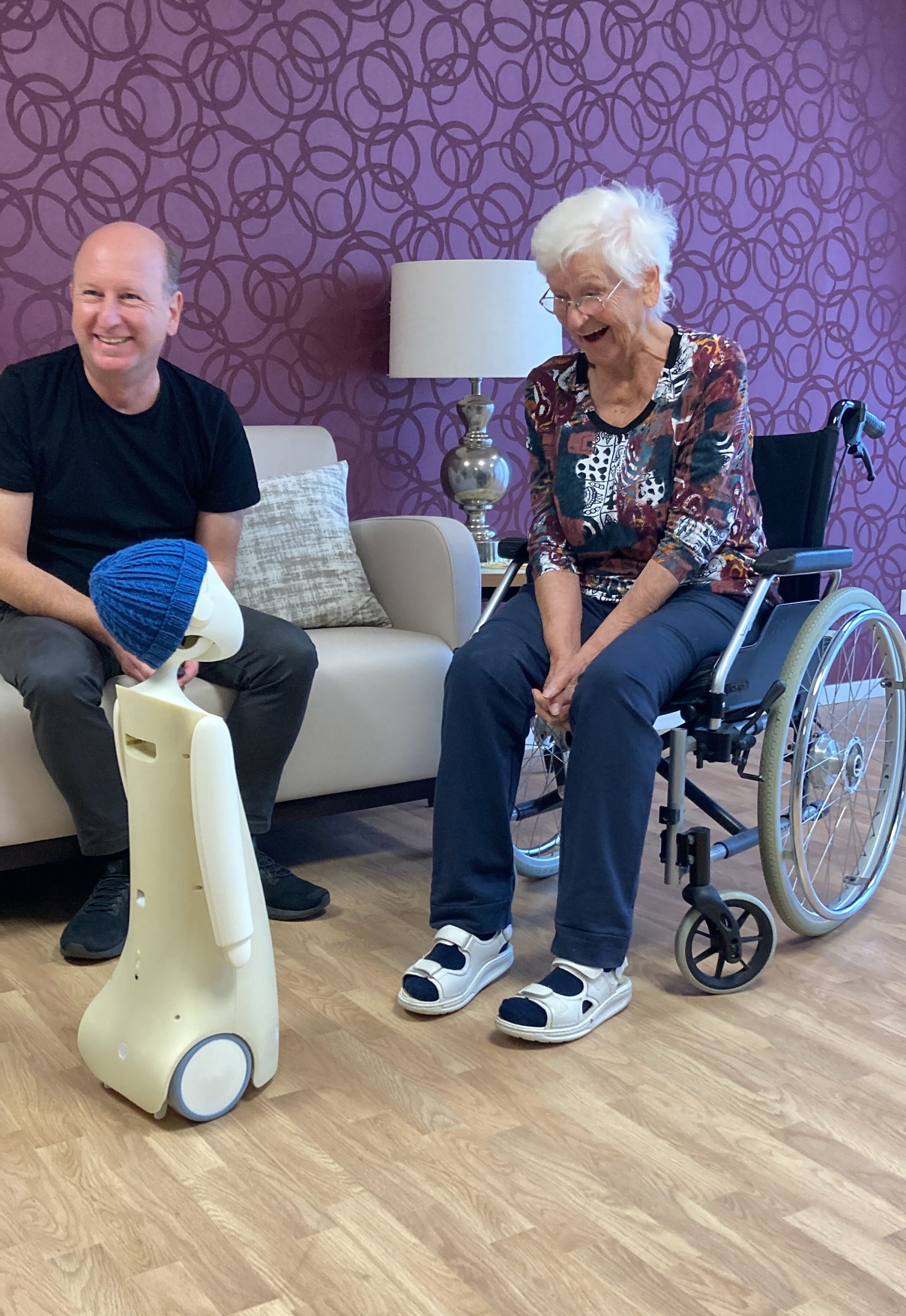
Robots in care
Nursing and care staff have a very heavy workload on both a physical and socio-emotional level. The social robot Navel focuses on cognitive and emotional care activities and provides relief in these areas. According to the Barmer Care Report 2023, the burden here is particularly high: more than one in two carers state that they are often or always emotionally exhausted. Just under half say they are rarely or never able to take regular breaks in their day-to-day work. A third of young carers are fed up with their job.
As a caregiver, for example, it is sometimes necessary to suppress one’s own emotions as appropriate to the situation, e.g. disgust or shame, sadness, anger, or to make them explicit and reflect on them. It is also sometimes necessary to reveal one’s own emotions, e.g. kindness, sincerity, gentleness. In addition, it is important to recognize the feelings of those affected and to deal with them, if necessary to influence them, always with the aim of fulfilling the care mandate. And this is constantly changing – with every interaction, the caregiver must reorient themselves socially, which is extremely demanding. Social interaction is particularly erratic due to the different stages of dementia and other cognitive and physical limitations.
Social superpowers of social robots
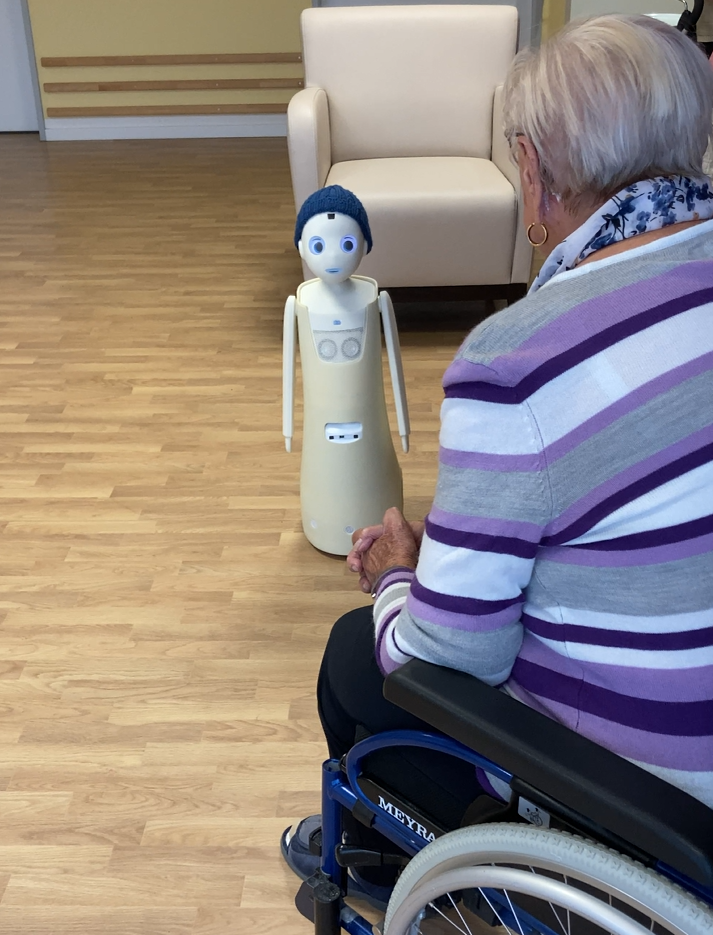
Humans have much broader and more sensitive abilities than robots in both physical and socio-emotional areas. On the other hand, robots have skills in individual disciplines that enable them to outperform humans: e.g. strength and precision in industry. And in the social field, Prof. Marc Hassenzahl from the University of Siegen speaks of “social superpowers” that social robots have:
- Endless patience
- Endless friendliness
- Never resentful
- No „thank you“ required
- Endless attention
- No conviction
- Unconditional positive attention
- 24/7 empathy
Expecting such skills from a human being would indeed be inhuman – like expecting a mechanic to build the engine block into a car chassis by hand without machine power. The strongest team is therefore always the human-robot team, in which the strengths of one can compensate for the weaknesses of the other.
Robots with empathy?
Navel uses large language models such as GPT from Open AI for its empathic abilities. But can a robot even come close to being as empathetic as a human?
Researchers at the University of California in San Diego came up with astonishing results in a study:
For this purpose, a group of doctors answered a selection of patient questions from an online forum. The same questions were submitted to ChatGPT for processing. The answers were analyzed by experts and showed a surprising result: In 78.6% of the 585 cases processed, the experts preferred the answer from ChatGPT compared to the answer from their medical colleagues. In addition, the ChatGPT advice was rated as significantly more empathetic. Compared to the doctors’ answers, the chatbot provided 9.8 times as many empathic or very empathic answers.
It is not surprising that empathy is embedded in the large language networks (Large Language Models, LLMs). After all, interpersonal interactions, and topics such as emotions and empathy are also covered countless times in the billions of training data, the texts.
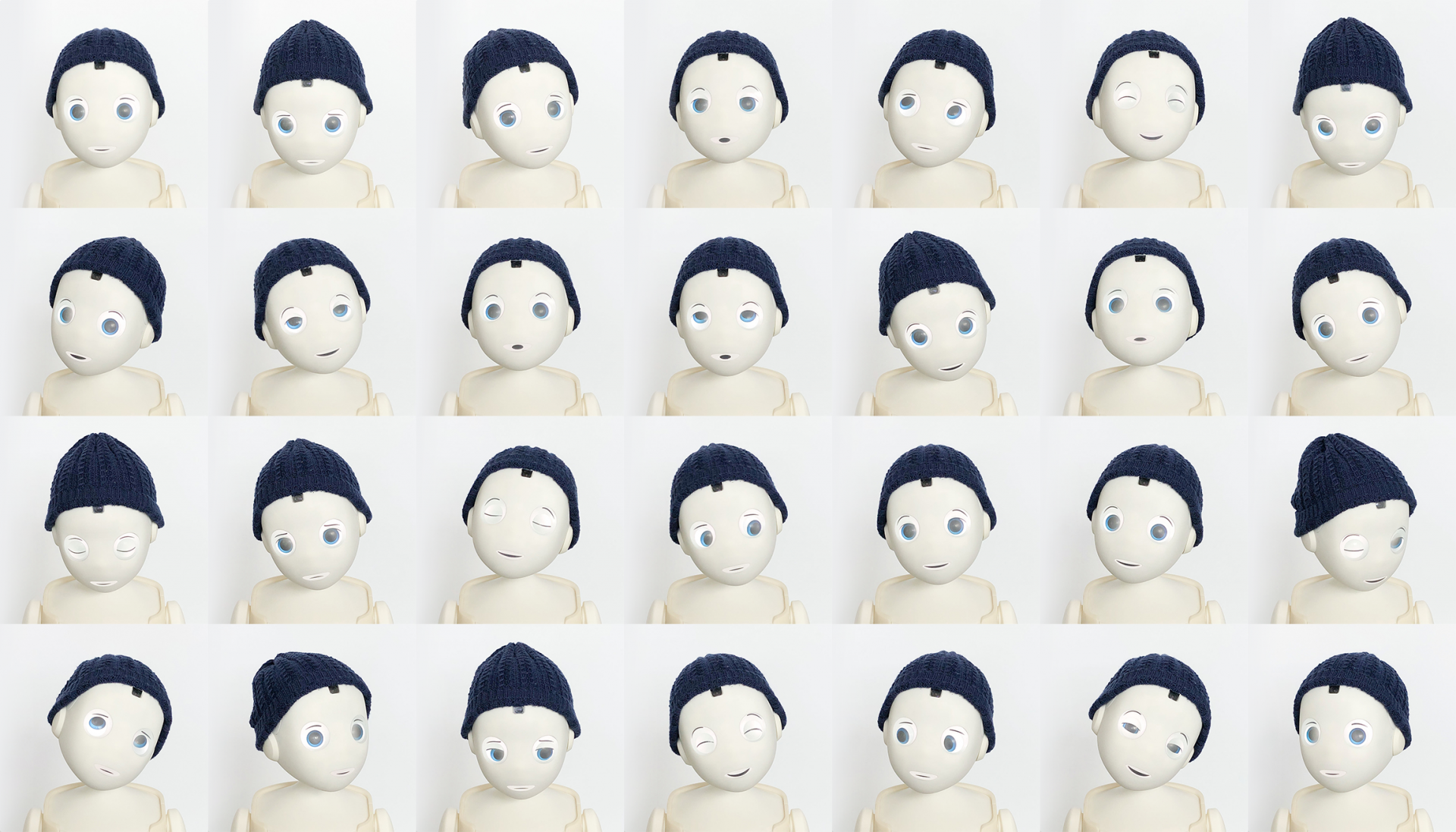
With navel robotics, we go one step further and distil the particularly empathetic parts from the language network. The social robot Navel uses its sensors (image and sound) to continuously record the context and social signals of its counterpart, such as facial expressions, attention, emotion, etc. – signals that are used for so-called affective empathy. With the help of this information and sophisticated dynamic prompt engineering, we can convey an understanding of the social situation to the language network and thus tailor the responses to empathy. This is because the usual social rules are also embedded in these networks, which we can use for Navel’s so-called cognitive empathy so that Navel can also adhere to these social rules.
Do people in need of care want to interact with social robots?
The social robot Navel was explicitly designed for broad acceptance and a high level of trust among all age groups. The design should neither resemble classic technical robots nor be as human as possible, as prescribed by the well-known concept of the “uncanny valley“. The solution is an abstracted human-like figure – like a comic character. It is important to support the strong human ability of non-verbal communication. After all, eye contact and facial expressions are essential for us humans in social interactions. Navel is the only robot in the world to support this with a unique solution that uses displays for the mouth and eyes, which are used for expressive facial expressions, in combination with special lenses that create three-dimensional eyeballs, which is a prerequisite for being able to establish real eye contact.
The result is not a scary “care robot” standing in front of those in need of care in the home, but a cute little creature that looks at people like a character from a Walt Disney animated film come to life and encourages them to laugh and talk.
Navel has been in use in nursing homes since October 2023 in pilot projects that are closely supervised by navel robotics. This allows the feedback of all those affected (care staff and people in need of care) to be incorporated into the further development of Navel – in a user-centered design and development process. We hear statements from those in need of care such as: “Talking to Navel is fun!”, “When Navel said that, my heart opened”, “Navel brings life into this place” “Talking to Navel is better than not talking at all. The nursing staff often don’t have time.”
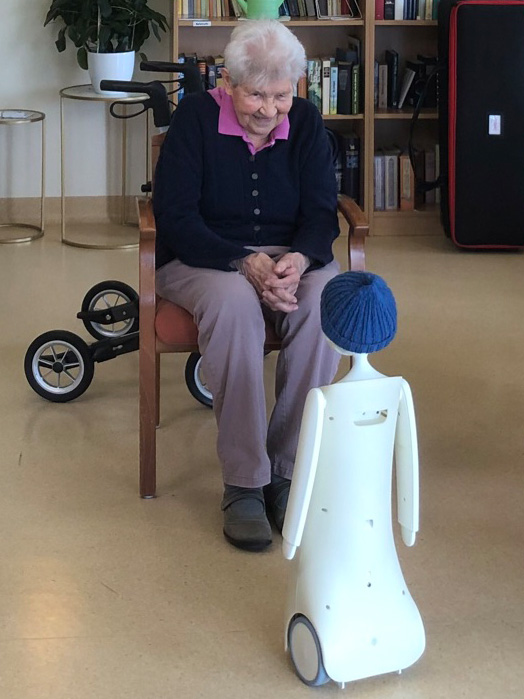
Use cases of the social robot Navel in care
There are numerous use cases for how Navel can support nursing homes.
Additional cognitive and emotional activation
Thanks to the use of artificial intelligence (large language models), Navel can communicate very flexibly with users on a wide range of topics. Thanks to local computer vision networks on the robot, Navel also recognizes when a resident is sitting alone in the hallway, for example. It will approach them and, thanks to facial recognition, can address them by name and ask how they are feeling. These small micro-interventions many times a day help to bring care home residents out of a passive, apathetic state.
In addition to small talk, Navel can also do targeted cognitive training. Navel can currently ask estimation questions. He can also recite many poems to bring back memories.
Navel remembers the topics of conversation it has had with individual people and can refer to them. Over time, Navel should also get to know the residents better, their preferences and their past, so that he can interact with them more individually. Overall, Navel’s strategy is to use questions of all kinds to encourage people to tell stories and thus activate them, rather than simply answering questions like Alexa. Navel also aims to ask specific questions from biographies and engage people in conversations.
Navel reacts empathetically to everything, laughs a lot, and always gives open-hearted compliments, so the residents are also positively activated emotionally.
Dementia
Relief
Today, Navel is still a pre-series product. Navel is currently only used in care settings under the supervision of nursing or care staff. This means that Navel does not provide additional activation on its own. Today, it helps care staff to activate residents together. The care staff themselves often have fun interacting with Navel and the residents. Navel knows a lot about many topics thanks to GPT. For example, the residents and care staff talk to Navel about eggnog recipes or trips to Canada. Navel brings stimulation and variety to everyday life.
In future, however, Navel will also be active autonomously in care homes. This means that it will be able to entertain and activate care home residents on its own and additionally. While the caregiver is busy with individual intervention or other activities, for example. Navel can also carry out smaller tasks for the care staff. For example, the carer can tell Navel: “Find Mr. Müller and tell him that the church service is about to start.”
Alleviate loneliness
How can Navel alleviate loneliness? Although a large number of people live closely together in care homes, there is a lot of loneliness there – because people withdraw. Studies repeatedly show that people sometimes find it easier to open up to a non-human or even technical counterpart because the socio-emotional demands are apparently lower. A carer from a Johanniter retirement home reported: “A resident had been diagnosed with cancer that day. She was very affected and withdrew and did not confide in anyone. She then told him about it during the intervention with Navel. Navel reacted very empathetically and told her that she was not alone and that the whole team was there to support her. Somehow a burden was lifted from her. She was more relaxed and was then able to talk about it with others.”
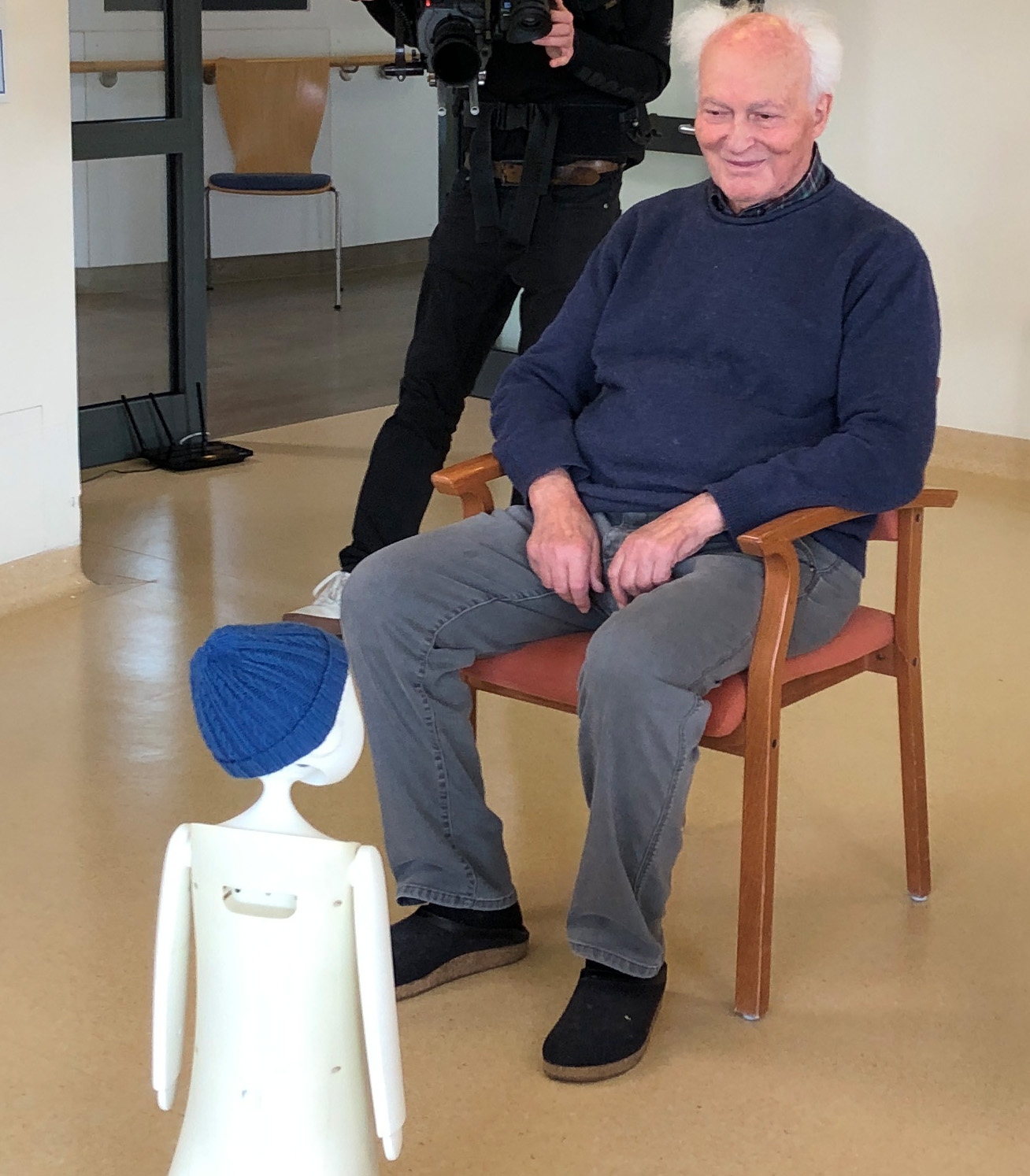
Positive atmosphere
The workload and stress levels for care staff are very high. The residents are crowded into a confined space with other people who may have completely different lifestyles and values. Aggression and anxiety are side effects of dementia. This is where the social superpowers of social robots like Navel can really come into their own.
A study by Yale University shows how social robots can positively influence the atmosphere and communication between people.
Social robots played a game together with two people who did not know each other. When the robots showed themselves to be vulnerable, e.g. because they made a mistake or communicated emotionally, e.g. when they won together, the two humans also communicated much more and much more openly with each other.
We are always delighted to see how Navel can put a smile on people’s faces with her empathetic comments and open-hearted compliments.
Future extensions
Numerous other use cases are being planned and will be implemented gradually. These include:
- Answer standard questions (weather, meal plan)
- Running Errands (“Tell everyone that church service is coming up”; “Find Mrs. Meier and tell her…”)
- Interventions in positive psychology
- Support with translating for care staff and residents who speak little German
- Support with documentation
Privacy policy at Navel
However, with all the achievements made possible by the latest technological developments, special attention must be paid to data protection – especially when using artificial intelligence, as defined in the currently emerging European AI Act.
This is why Navel’s architecture is designed from the ground up to handle personal data as carefully as possible. In particular, the highly sensitive image data that Navel continuously captures to perceive its environment and conversation partners is captured, evaluated and immediately deleted directly on the robot in 100 milliseconds thanks to a very powerful processor. The images are not stored, let alone sent to a cloud for analysis.
Large language models such as GPT are still so large that they unfortunately cannot yet be used locally on a robot. Navel uses services on European servers for this purpose, meeting EU legal requirements.
In addition, detailed strategies on how to handle personal data were developed together with the care providers and their external data protection officers. This begins with topics such as informing those affected and obtaining declarations of consent, and naturally extends to a wide range of technical and organizational measures through to contracts for handling personal data and the allocation of responsibilities.
